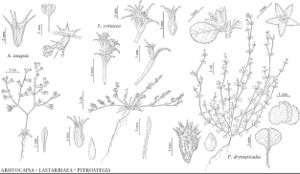Difference between revisions of "Pterostegia drymarioides"
Index Seminum (St. Petersburg) 2: 48. 1836.
FNA>Volume Importer |
imported>Volume Importer |
||
| (One intermediate revision by the same user not shown) | |||
| Line 6: | Line 6: | ||
|place=2: 48. 1836 | |place=2: 48. 1836 | ||
|year=1836 | |year=1836 | ||
| + | }} | ||
| + | |special_status={{Treatment/ID/Special_status | ||
| + | |code=F | ||
| + | |label=Illustrated | ||
}} | }} | ||
|basionyms= | |basionyms= | ||
| Line 45: | Line 49: | ||
|publication title=Index Seminum (St. Petersburg) | |publication title=Index Seminum (St. Petersburg) | ||
|publication year=1836 | |publication year=1836 | ||
| − | |special status= | + | |special status=Illustrated |
| − | |source xml=https:// | + | |source xml=https://bitbucket.org/aafc-mbb/fna-data-curation/src/2e0870ddd59836b60bcf96646a41e87ea5a5943a/coarse_grained_fna_xml/V5/V5_1002.xml |
|subfamily=Polygonaceae subfam. Eriogonoideae | |subfamily=Polygonaceae subfam. Eriogonoideae | ||
|genus=Pterostegia | |genus=Pterostegia | ||
Latest revision as of 22:07, 5 November 2020
Plants 0.1–10(–12) dm across. Leaves: petiole 0.2–0.6(–1) cm; blade 0.3–2 × 0.5–2.5(–3) cm. Involucral bracts 1–1.5(–3) × (1.5–)2-3(–3.5) mm. Flowers: perianth 0.9–1.2 mm; filaments 0.5–0.6 mm; anthers 0.2–0.3 mm. Achenes 1.2–1.5 mm. 2n = 28.
Phenology: Flowering Mar–Jul.
Habitat: Sandy to gravelly soils in shady places in grassland and chaparral communities, and in oak-pine or occasionally montane conifer woodland
Elevation: 0-1600 m
Distribution

Ariz., Calif., Nev., Utah, Mexico (Baja California).
Discussion
The only presumed Oregon collection of Pterostegia drymarioides (Tolmie s.n., GH) was gathered along the Columbia River sometime in the 1830s. The only collection reportedly from New Mexico (Parry et al. 1171, US) supposedly was found in the Rio Grande Valley in the 1850s during the United States-Mexico Boundary Survey. The species likely will be found in southern Oregon (not northern), but it is unlikely that it ever occurred in New Mexico. A problem is that this species is often difficult to notice, as the plants tend to be in the shade under shrubs. Specimens often are misidentified as Parietaria (Urticaceae)—See Flora of North America volume 3, pages 406–408.
Selected References
None.
